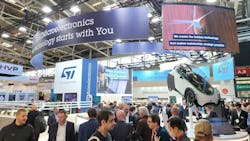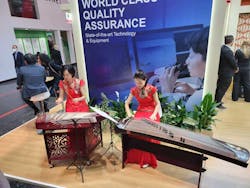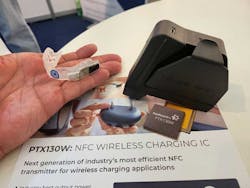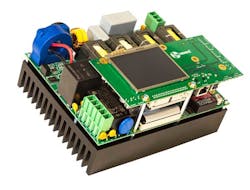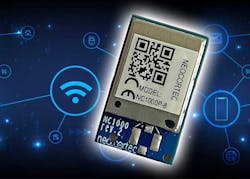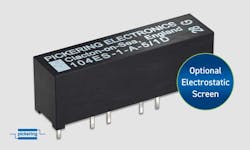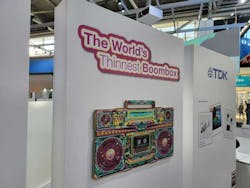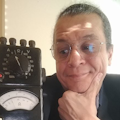The Design Engineering Community Came to Town at electronica
Check out more of coverage of Electronica 2022.
What you'll learn:
- Takeaways on the overall atmosphere of the return of electronica.
- Programs at the show.
- Spotlight on a handful of the scores of standout products on display.
In the recent months following the pulling back of many COVID-related travel restrictions, the trade-show circuit has begun to warm up again. The latest shows in the electronics industry have experienced relatively lackluster attendance, although thankfully with high levels of interest in the attendees—there are few, if any, “pen collectors” in these smaller crowds. However, electronica 2022 returned with an impressive showing after its four-year hiatus, with only a 14% drop in attendance compared to its show record in 2018.
Beyond the strong attendance, a very strong feeling of positive energy filled the air, and everyone had a sense of “we’re back” as evidenced in the activity and interest in their booths and exhibits. The fact that there was a great deal of pent-up interest in the latest solutions, which were met with numerous new releases created in COVID isolation, only sweetened the experience. The camaraderie and community of our industry was exemplified in the good nature and positive vibes in the activities and discussions (Fig. 1).
An Aggregation of Information
The show itself took up 14 halls that housed 2,144 exhibitors, 64% from countries outside of Germany. In addition, electronica also hosted SEMICON Europa, which was held in parallel in a couple of halls.
A supporting program of conferences, forums, and special events like the CEO Roundtable provided an opportunity for discussions on issues impacting the industry. These included current global challenges ranging from the energy transition and supply-chain bottlenecks to the scarcity of raw materials and the skilled-worker shortage. There were also cultural exhibits at some of the national pavilions (Fig. 2).
The supporting program included the latest topics and challenges, such as sustainability. Many exhibits in the booths and several discussion topics at the conferences and forums focused on fomenting sustainable technologies.
Another program addressed the shortage of skilled workers with a range of career initiatives, including on-site recruiting, Student Day, and a job exchange for exhibitors and job starters with the aim of getting young people, especially women, into the industry. A Fast Forward platform promoted young talent with a stage for selected startups to present their innovations.
Technology Highlights
There were too many new products, services, and solutions unveiled at electronica to present them all. What follows are a few examples of the standout products found at the trade show. Every aspect of electronic design, development, and manufacturing in our industry is important—there’s no intended judgment in any publication or omission of any solution from the event.
In an example of how sophisticated electronic solutions can address old problems, one product shown by Panthronics, a near-field communications (NFC) technology and products developer, tracks the impacts of collisions on football players with a wireless sensor implanted in a rechargeable smart mouthguard (Fig. 3). The nature of the solution enables it to be very tightly coupled to the player’s skull without potentially dangerous hard sensors in the helmet itself.
Named a CES 2022 Innovation Awards Honoree, the company’s NFC wireless-charging technology enables manufacturers of portable and wearable devices to quickly implement the hardware and software for an NFC wireless-charging system as used in this smart mouthpiece. Panthronics’ DiRAC tech also simplifies the antenna matching for NFC wireless charging, reducing development effort, size, and cost.
We’ve been hearing about wide-bandgap materials like gallium nitride (GaN) and silicon carbide (SiC) for some time now, and more solutions are being fielded that include the technology. One example was found at the booth of Cambridge GaN Devices, which unveiled its IceGaN smart HEMT-based monolithically integrated power solutions (Fig. 4).
The company’s IceGaN HEMTs are fully integrated, GaN-only devices available in an extended voltage range of up to 20 V. Features include a Miller clamp for safe turn-off and gate protection, integrated ESD protection, and no negative voltage requirement, which avoids potential problems of dynamic on-resistance (RDS(on)) degradation over time.
Wireless capability for cloud-based functionality is another hot area. NeoCortec’s P Series of wireless NeoMesh modules have an RF/IO antenna connection located under the module on solder pads for quick and easy soldering to any PCB (Fig. 5). The modules enable a higher-efficiency antenna design as well as a more compact design of the sensor or actuator.
The NC1000P-8, NC1000P-9, and NC2400P NeoMesh modules operate at 868 MHz, 915 MHz, and 2.4 GHz respectively. They complement the already-available C-Series modules, which have a u.FL connector, are used whenever an external connector is needed. Cost-effective and easy to integrate, all of the modules from NeoCortec suit a broad range of applications based on IoT and cloud-based sensor networks.
Board-Level Solutions
People tend to lose sight of the pressure on the component industry to keep up with the demands being placed on them by advanced circuit topologies driven by next-generation core technologies.
To address the need for lower noise and interference in a circuit, for example, Pickering Electronics launched a variant of its high-voltage Series 104 SIL/SIP reed-relay family with optional electrostatic shielding between the switch and coil (Fig. 6). This minimizes noise between the coil drive and high-voltage circuits, and can eliminate problems due to magnetic interaction when devices are closely stacked.
Series 104 reed relays suit applications in testers for renewable technologies such as solar or EV battery testing, transformer or cable testing, or any other automatic test equipment involving high voltages or where mains voltages are switched. Four types of dry switches are available, capable of standing-off 1.5, 2, 3, and 4 kV dc.
The 3- and 4-kV versions have an increased clearance between the switch and coil pins to accommodate the higher voltage; higher voltage ratings are available. Also in the mix are mercury-wetted devices for applications that require bounce-free switching.
Power Integrations released the InnoSwitch4-Pro family of digitally controllable, offline CV/CC zero-voltage-switching (ZVS) flyback ICs that incorporate a robust PowiGaN gallium-nitride primary switch (Fig. 7). Offering a steady-state switching frequency of up to 140 kHz, the highly integrated devices reduce the component count and PCB area required.
ZVS combined with PowiGaN technology virtually eliminates switching losses, achieving efficiencies in excess of 95%. Further size reduction can be attained by using a MinE-CAP device in combination with InnoSwitch4-Pro and ClampZero ICs.
On the fun and interesting side, TDK had what it claimed is the thinnest “Boombox” in the world (Fig. 8). Made in partnership with Joe “Kingpin” Grand, the “World’s Thinnest Boombox” uses TDK’s ultra-thin PiezoListen line of speakers.
Born of Grand’s affection for the music and culture of the 1980s, the portable sound system is as much art as technology. The boombox project is an open-source music player complete with custom circuit board artwork, capacitive-touch-sensing buttons, and ultra-thin piezo speaker elements by TDK, and includes a bundle of the company’s capacitors and inductors.
The next electronica will take place in Munich from November 12-15, 2024.
Check out more of coverage of Electronica 2022.
About the Author
Alix Paultre
Editor-at-Large, Electronic Design
An Army veteran, Alix Paultre was a signals intelligence soldier on the East/West German border in the early ‘80s, and eventually wound up helping launch and run a publication on consumer electronics for the US military stationed in Europe. Alix first began in this industry in 1998 at Electronic Products magazine, and since then has worked for a variety of publications in the embedded electronic engineering space. Alix currently lives in Wiesbaden, Germany.
Also check out his YouTube watch-collecting channel, Talking Timepieces.
